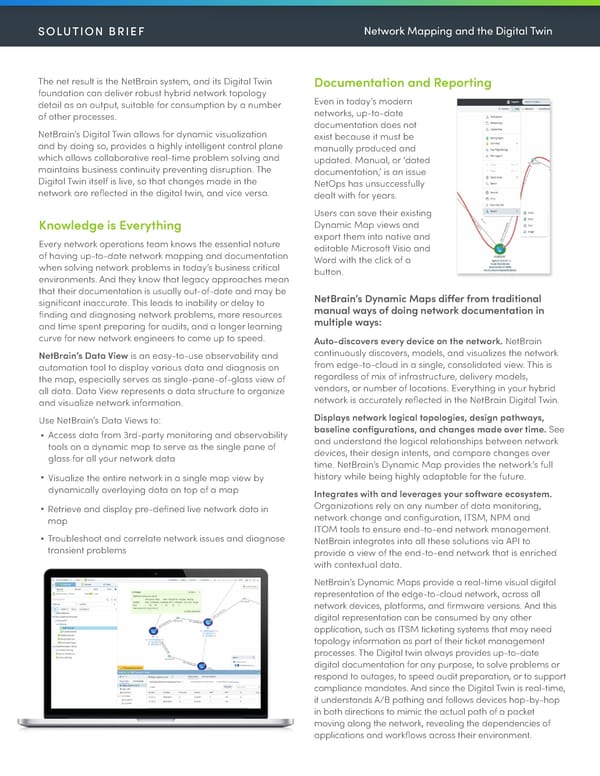SOLUTION BRIEF Network Mapping and the Digital Twin The net result is the NetBrain system, and its Digital Twin Documentation and Reporting foundation can deliver robust hybrid network topology Even in today’s modern detail as an output, suitable for consumption by a number networks, up-to-date of other processes. documentation does not NetBrain’s Digital Twin allows for dynamic visualization exist because it must be and by doing so, provides a highly intelligent control plane manually produced and which allows collaborative real-time problem solving and updated. Manual, or ‘dated maintains business continuity preventing disruption. The documentation,’ is an issue Digital Twin itself is live, so that changes made in the NetOps has unsuccessfully network are reflected in the digital twin, and vice versa. dealt with for years. Users can save their existing Knowledge is Everything Dynamic Map views and Every network operations team knows the essential nature export them into native and of having up-to-date network mapping and documentation editable Microsoft Visio and when solving network problems in today’s business critical Word with the click of a environments. And they know that legacy approaches mean button. that their documentation is usually out-of-date and may be NetBrain’s Dynamic Maps differ from traditional significant inaccurate. This leads to inability or delay to manual ways of doing network documentation in finding and diagnosing network problems, more resources multiple ways: and time spent preparing for audits, and a longer learning curve for new network engineers to come up to speed. Auto-discovers every device on the network. NetBrain NetBrain’s Data View is an easy-to-use observability and continuously discovers, models, and visualizes the network automation tool to display various data and diagnosis on from edge-to-cloud in a single, consolidated view. This is the map, especially serves as single-pane-of-glass view of regardless of mix of infrastructure, delivery models, all data. Data View represents a data structure to organize vendors, or number of locations. Everything in your hybrid and visualize network information. network is accurately reflected in the NetBrain Digital Twin. Use NetBrain’s Data Views to: Displays network logical topologies, design pathways, • Access data from 3rd-party monitoring and observability baseline configurations, and changes made over time. See tools on a dynamic map to serve as the single pane of and understand the logical relationships between network glass for all your network data devices, their design intents, and compare changes over time. NetBrain’s Dynamic Map provides the network’s full • Visualize the entire network in a single map view by history while being highly adaptable for the future. dynamically overlaying data on top of a map Integrates with and leverages your software ecosystem. • Retrieve and display pre-defined live network data in Organizations rely on any number of data monitoring, map network change and configuration, ITSM, NPM and • Troubleshoot and correlate network issues and diagnose ITOM tools to ensure end-to-end network management. transient problems NetBrain integrates into all these solutions via API to provide a view of the end-to-end network that is enriched with contextual data. NetBrain’s Dynamic Maps provide a real-time visual digital representation of the edge-to-cloud network, across all network devices, platforms, and firmware versions. And this digital representation can be consumed by any other application, such as ITSM ticketing systems that may need topology information as part of their ticket management processes. The Digital twin always provides up-to-date digital documentation for any purpose, to solve problems or respond to outages, to speed audit preparation, or to support compliance mandates. And since the Digital Twin is real-time, it understands A/B pathing and follows devices hop-by-hop in both directions to mimic the actual path of a packet moving along the network, revealing the dependencies of applications and workflows across their environment.
 Mapping & Digital Twin Page 2 Page 4
Mapping & Digital Twin Page 2 Page 4